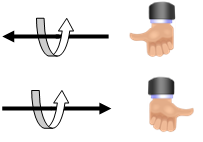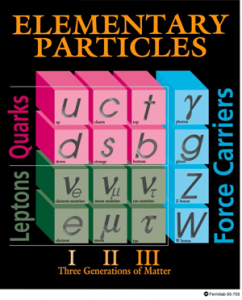At the time the Standard Model was constructed, it was assumed that:
- neutrinos have exactly zero mass;
- there are exactly three neutrinos, one for each of the three charged leptons, and lepton neumber is conserved separately for each of the three lepton families (e, νe), (μ, νμ), (τ, ντ);
- neutrinos and antineutrinos are distinct;
- all neutrinos are left-handed (see figure 9), and all antineutrinos are right-handed.
These were the conclusions of 20 years of experimental work since the discovery of the neutrino. They were well described by the two-component model of the neutrino, which had been invented in the late 1950s by Lee and Yang, Landau, and Salam. The key ingredient of this model is the massless nature of neutrinos: if neutrinos have exactly zero mass, then their handedness (or helicity) is a permanent property, and there is no way for a neutrino created as an electron-neutrino to change into any other type. Neutrinos were the only massless matter particles in the Standard Model (photons and gluons are also massless, but they’re force carriers, not matter particles) – but as masses were one of the properties that the Standard Model assumes but does not explain, this did not seem to be unreasonable.

Figure 9: helicity. Particles such as the neutrino have a property called spin, which is a quantum-mechanical version of what we normally mean by spin. The spin of a particle like a neutrino or an electron can be either right-handed, as in the top picture, or left-handed, as in the lower picture. The weak interaction selects left-handed particles and right-handed antiparticles. Note that an observer who was moving faster than the particle would see the particle’s velocity change direction (if you are moving rapidly left to right, the lower particle will seem to you to be moving right to left), but its spin would remain the same – therefore its observed helicity would change.
The handedness of a particle is only a fixed quantity, the same for all observers, if the particle has exactly zero mass (because then it will travel at the speed of light, and cannot be overtaken). Massive particles can be seen as either left-handed or right-handed depending on the motion of the observer. Therefore, if neutrinos turn out to have non-zero mass, the two-component model breaks down, and the Standard Model must be modified. It turns out that the other properties of the original model of neutrinos – the distinctness of the three flavours, and the difference between neutrinos and antineutrinos – also depend critically on the masslessness of neutrinos.




